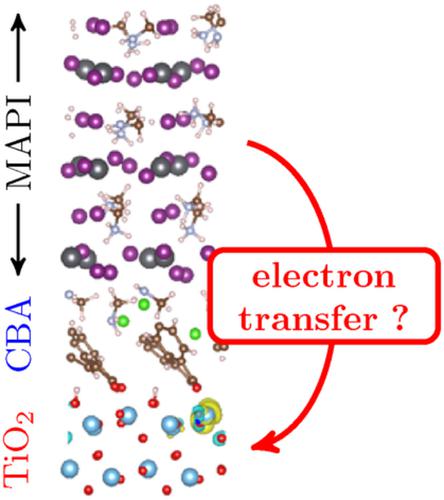当前位置:
X-MOL 学术
›
J. Comput. Chem.
›
论文详情
Our official English website, www.x-mol.net, welcomes your
feedback! (Note: you will need to create a separate account there.)
Improving the heterointerface in hybrid organic–inorganic perovskite solar cells by surface engineering: Insights from periodic hybrid density functional theory calculations
Journal of Computational Chemistry ( IF 3.4 ) Pub Date : 2020-04-30 , DOI: 10.1002/jcc.26215 Jun Su 1 , Tao Zhu 2 , Thierry Pauporté 2 , Ilaria Ciofini 1 , Frédéric Labat 1
Journal of Computational Chemistry ( IF 3.4 ) Pub Date : 2020-04-30 , DOI: 10.1002/jcc.26215 Jun Su 1 , Tao Zhu 2 , Thierry Pauporté 2 , Ilaria Ciofini 1 , Frédéric Labat 1
Affiliation

|
A periodic hybrid density functional theory computational strategy is presented to model the heterointerface between the methylammonium lead iodide (MAPI) perovskite and titanium dioxide (TiO2), as found in perovskite solar cells (PSC), where the 4‐chlorobenzoic acid (CBA) ligand is used to improve the stability and the band alignment at the interface. The CBA ligand acts as a bifunctional linker to efficiently connect the perovskite and the oxide moieties, ensuring the stability of the interface through Ti–O and Pb–Cl interactions. The computed density of states reveals that the perovskite contributes to the top of the valence band while the oxide contributes to the bottom of the conduction band with a direct bandgap of 2.16 eV, indicating a possible electron transfer from MAPI to TiO2. Dipole moment analysis additionally reveals that the CBA ligand can induce a favorable effect to improve band alignment and thus electron transfer from MAPI to TiO2. This latter has been quantified by calculation of the spin density of the reduced MAPI/CBA/TiO2 system and indicates an almost quantitative (99.94%) electron transfer from MAPI to TiO2 for the surface engineered system, together with an ultrafast electron injection time in the femtosecond timescale. Overall, the proposed DFT‐based computational protocol therefore indicates that surface engineering and the use of a bifunctional linker can lead to a better stability, together with improved band alignment and electron injection in PSC systems.
中文翻译:

通过表面工程改善混合有机-无机钙钛矿太阳能电池的异质界面:周期性混合密度泛函理论计算的见解
提出了一种周期性混合密度泛函理论计算策略来模拟甲基铵碘化铅 (MAPI) 钙钛矿和二氧化钛 (TiO2) 之间的异质界面,如钙钛矿太阳能电池 (PSC) 中发现的,其中 4-氯苯甲酸 (CBA) 配体用于提高界面的稳定性和能带对齐。CBA 配体作为双功能接头有效连接钙钛矿和氧化物部分,通过 Ti-O 和 Pb-Cl 相互作用确保界面的稳定性。计算出的态密度表明钙钛矿有助于价带顶部,而氧化物有助于导带底部,直接带隙为 2.16 eV,表明电子可能从 MAPI 转移到 TiO2。偶极矩分析还表明,CBA 配体可以诱导改善能带排列的有利效果,从而改善从 MAPI 到 TiO2 的电子转移。后者已通过计算减少的 MAPI/CBA/TiO2 系统的自旋密度进行量化,并表明表面工程系统从 MAPI 到 TiO2 的电子转移几乎是定量的(99.94%),以及超快的电子注入时间飞秒时标。因此,总体而言,所提出的基于 DFT 的计算协议表明,表面工程和双功能接头的使用可以带来更好的稳定性,同时改善 PSC 系统中的能带对齐和电子注入。后者已通过计算减少的 MAPI/CBA/TiO2 系统的自旋密度进行量化,并表明表面工程系统从 MAPI 到 TiO2 的电子转移几乎是定量的(99.94%),以及在飞秒时标。因此,总体而言,所提出的基于 DFT 的计算协议表明,表面工程和双功能接头的使用可以带来更好的稳定性,同时改善 PSC 系统中的能带对齐和电子注入。后者已通过计算减少的 MAPI/CBA/TiO2 系统的自旋密度进行量化,并表明表面工程系统从 MAPI 到 TiO2 的电子转移几乎是定量的(99.94%),以及超快的电子注入时间飞秒时标。因此,总体而言,所提出的基于 DFT 的计算协议表明,表面工程和双功能接头的使用可以带来更好的稳定性,同时改善 PSC 系统中的能带对齐和电子注入。
更新日期:2020-04-30
中文翻译:

通过表面工程改善混合有机-无机钙钛矿太阳能电池的异质界面:周期性混合密度泛函理论计算的见解
提出了一种周期性混合密度泛函理论计算策略来模拟甲基铵碘化铅 (MAPI) 钙钛矿和二氧化钛 (TiO2) 之间的异质界面,如钙钛矿太阳能电池 (PSC) 中发现的,其中 4-氯苯甲酸 (CBA) 配体用于提高界面的稳定性和能带对齐。CBA 配体作为双功能接头有效连接钙钛矿和氧化物部分,通过 Ti-O 和 Pb-Cl 相互作用确保界面的稳定性。计算出的态密度表明钙钛矿有助于价带顶部,而氧化物有助于导带底部,直接带隙为 2.16 eV,表明电子可能从 MAPI 转移到 TiO2。偶极矩分析还表明,CBA 配体可以诱导改善能带排列的有利效果,从而改善从 MAPI 到 TiO2 的电子转移。后者已通过计算减少的 MAPI/CBA/TiO2 系统的自旋密度进行量化,并表明表面工程系统从 MAPI 到 TiO2 的电子转移几乎是定量的(99.94%),以及超快的电子注入时间飞秒时标。因此,总体而言,所提出的基于 DFT 的计算协议表明,表面工程和双功能接头的使用可以带来更好的稳定性,同时改善 PSC 系统中的能带对齐和电子注入。后者已通过计算减少的 MAPI/CBA/TiO2 系统的自旋密度进行量化,并表明表面工程系统从 MAPI 到 TiO2 的电子转移几乎是定量的(99.94%),以及在飞秒时标。因此,总体而言,所提出的基于 DFT 的计算协议表明,表面工程和双功能接头的使用可以带来更好的稳定性,同时改善 PSC 系统中的能带对齐和电子注入。后者已通过计算减少的 MAPI/CBA/TiO2 系统的自旋密度进行量化,并表明表面工程系统从 MAPI 到 TiO2 的电子转移几乎是定量的(99.94%),以及超快的电子注入时间飞秒时标。因此,总体而言,所提出的基于 DFT 的计算协议表明,表面工程和双功能接头的使用可以带来更好的稳定性,同时改善 PSC 系统中的能带对齐和电子注入。











































 京公网安备 11010802027423号
京公网安备 11010802027423号